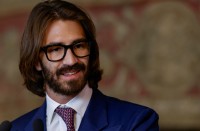Kengo Kuma, the architect of the 2020 Tokyo Olympics stadium, on Friday (January 15) strongly rejected accusations that he copied the design by British-Iraqi architect Zaha Hadid.
A futuristic design proposed by architect Hadid was originally chosen in an international contest to build the centrepiece stadium, but it was dropped last year due to ballooning costs.
A design by Japanese architect Kengo Kuma with a price tag of 149 billion yen ($1.27 billion), as opposed to an estimated $2.1 billion for Hadid’s plans, was chosen last month instead.
Speaking to reporters at the Foreign Correspondents Club of Japan in Tokyo on Friday about the new design, Kuma refuted claims that he had borrowed from Hadid’s design.
“In regard to the question about similarities, I believe if you take a look at the designs of Ms. Zaha Hadid and also of myself you can see a very different impression of the buildings,” he said.
Controversy had been further stoked by the collaboration between Kuma and the original contractors, Taisei Construction Corp, whom Hadid claims had access to all detailed drawings of the original design.
Whilst recognising that constraints of the project inevitably led to similarities in details such as the angles of the design or the number of spectator seats permitted per row, Kuma insisted the fundamental approaches of the designs diverged.
“The concept which is being aimed for and which is being realised in the design of Zaha and also in our design is completely different,” he said. “We are looking at the saddle design versus our flat design and a completely different concept in the way this is being approached,” Kuma said.
Kuma strongly renounced suggestions that discrimination against foreigners had played a part in the decision to scrap Hadid’s design.
“I personally do not feel like any concerns about not wanting a foreigner involved in Japan’s national stadium were at play at all. I don’t think this is an issue,” he said.
“However, I would like to say that it is perhaps difficult in some respects for architects from other countries to be working within Japan,” he added.
In contrast to Hadid’s original design that was heavily criticised for not being in-keeping with its green location, Kuma emphasised that his design would harmonise with nature and its surroundings.
“We have tried to use natural materials as much as possible in the design, particularly wood, and ensuring that those in the stadium can actually feel the warmth of this wood surrounding as well,” he said.
However, Kuma said that it was not yet confirmed whether this would come from sustainable Forest Stewardship Council (FSC) approved sources.
The controversy over the stadium is just one of a series of embarrassments for Tokyo Olympics planners, which also saw the original Tokyo 2020 Olympics logo design scrapped due to accusations of plagiarism.








